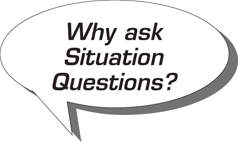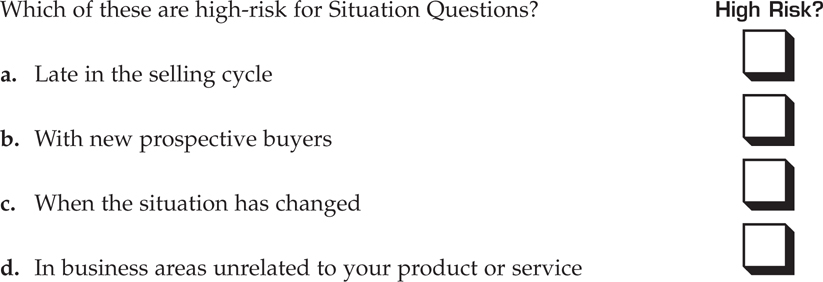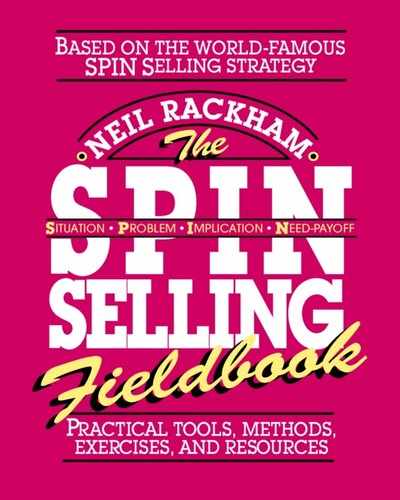7
Situation Questions

Overview
A Situation Question asks for
![]() Background
Background
![]() Facts
Facts
about the buyer’s existing situation.


They help establish a context for uncovering buyer problems.
Since the purpose of questions in larger sales is to uncover Implied Needs and develop them into Explicit Needs, effective sellers ask Situation Questions selectively. They provide:
![]() Neutral factual information that helps you understand the customer’s situation.
Neutral factual information that helps you understand the customer’s situation.
![]() A starting place for deciding which potential problems and dissatisfactions to explore.
A starting place for deciding which potential problems and dissatisfactions to explore.
Huthwaite’s research shows that inexperienced sellers often ask too many Situation Questions or ask them inappropriately. While Situation Questions are an important step in successful selling, asking too many risks losing credibility with the buyer.
The best way to use Situation Questions is to:
![]() Do your homework before meeting the buyer, so that you’re not asking about basic facts and background information that is available elsewhere.
Do your homework before meeting the buyer, so that you’re not asking about basic facts and background information that is available elsewhere.
![]() Focus your Situation Questions to get key information in those areas most likely to uncover buyer problems you can develop into Explicit Needs.
Focus your Situation Questions to get key information in those areas most likely to uncover buyer problems you can develop into Explicit Needs.

CHECK YOURSELF—SITUATION QUESTIONS
Before we go into more detail on using Situation Questions effectively, let’s be sure you’re clear about what makes them different from other types of questions. Decide which of the following examples are Situation Questions.
(Yes or No) Situation Question?
1. 
2. 
3. 
4. 
5. 
6. 
7. 
8. 
Answers are on the next page.
SITUATION QUESTIONS—ANSWERS
1. Yes Asking for background information.
2. Yes Seeking to understand how the business operates.
3. No The seller is probing for background problems. So this is a Problem Question, which we’ll cover in depth in Chapter 8.
4. No Another Problem Question, asked more indirectly.
5. Yes The seller is checking understanding of the buyer’s present market situation. Note: This would be a Problem Question if it were asked as “Are you concerned about heavy competition from small subcontractors?”
6. Yes The seller is asking for a fact. No problem has yet been uncovered.
7. No This question probes for concerns the buyer may have (“… are you worried?”) regarding the increased workload. So this is a Problem Question, but it’s a tricky one: If the customer had already stated that the increased workload was a problem, then this would be an Implication Question, asking about the effect of that workload problem on maintenance costs.
8. Yes The seller is asking for a neutral fact. If the answer is that the number fell short of the original projection, then the seller could follow up with a Problem Question to determine if the buyer is dissatisfied with the shortfall.
Using Situation Questions Effectively
After you’ve done your homework to get basic information about your potential buyer’s business, it’s important to plan the Situation Questions you’ll ask during a face-to-face meeting.

Don’t be a prosecutor—be a problem solver
The two main considerations for asking Situation Questions are:
1. Selecting the Situation Questions so that you limit the number you’ll ask and still obtain the information you need.
2. Phrasing your Situation Questions so that they help the buyer see you as a problem solver rather than as a prosecutor.
Let’s look at each of these considerations in turn.
Selecting Appropriate Situation Questions
Focusing your Situation Questions prevents you from overloading buyers with questions that might benefit you but bore them—and might even cause you to lose the sale at the very beginning of the Investigating stage.
The best way to avoid asking unnecessary Situation Questions is to:
![]() Be sure each question you ask has a clear purpose.
Be sure each question you ask has a clear purpose.
![]() Ask questions that are related to problems you believe a potential buyer may have that your product or service can resolve.
Ask questions that are related to problems you believe a potential buyer may have that your product or service can resolve.
Later on in this chapter, we’ll also review when to ask—and not ask—Situation Questions.
Planning Situation Questions
Is there a practical method for preparing appropriate Situation Questions? Yes.
Remember the precall planning you did in earlier chapters to anticipate Implied and Explicit Needs? You can use a similar approach to prepare selected Situation Questions ahead of your customer or client meeting.
Here’s how:
1. List some potential problems your product or service could resolve.
2. Determine what factual information you will need before you can effectively investigate those problems.
There can be several different answers in a case like our example on the next page. But what you’ll usually find is that:
![]() The right Situation Question can lead smoothly and naturally into discussion of the potential problem.
The right Situation Question can lead smoothly and naturally into discussion of the potential problem.
![]() You’ll need to ask several Situation Questions before you have enough background to investigate a problem area.
You’ll need to ask several Situation Questions before you have enough background to investigate a problem area.
Now, try this approach using your own product or service.
Phrasing Your Situation Questions
In certain cases you may get extensive background information before you’re positioned to move into problem identification. Since customer interest is generally low during this initial phase, it’s important to phrase your questions in a way that will be as acceptable as possible to your customer or client.
Most prospective buyers become irritated if the seller throws a series of blunt and largely unrelated questions at them, such as these questions that a specialty security consultant might ask:
What kind of billabongs do you produce here?
What kind of chips do they use?
How do you store your chips?
How old is the local facility?
Who’s in charge of security for the plant?
How many people work on the night shift?
Such a list of blunt “who, what, how, when, and where” questions can be perceived as a demand for information rather than an attempt to understand the key areas of your buyer’s business situation. How can you avoid creating this negative perception?
Linking Your Questions
By linking your questions, you can make them flow more smoothly and relate more naturally to your buyer’s business concerns:
1. Linking your questions to buyer statements can weld a series of questions into a coherent pattern.
2. Linking your questions to personal observation can add variety to your questioning and impress the buyer with your alertness.
3. Links to third-party situations can boost your credibility, if you can demonstrate understanding and experience with the buyer’s business.
Let’s look at some examples in the following conversation …
SELLER What kind of billabongs do you produce at this plant?
BUYER We turn out a number of lines, but our principal products are megabillabongs.
SELLER Megabillabongs? What kind of wheezos do they use? (Links to the buyer’s statement.)
BUYER We use two kinds of wheezos: general-purpose Cirrus wheezos and Terra wheezos for special 3-D functions.
SELLER I understand that many billabong manufacturers typically keep a three-month supply of Terra wheezos in their component inventory to cover import-related contingencies. Is that about right for your company? (Links to a third-party situation.)
BUYER Yes. In fact, demand for our megabillabongs has increased so much in the last two quarters that we’re actually stocking about 20 percent over that.
SELLER During the plant tour, I noticed that there was a large locked “clean room” behind the assembly area. Is that where you store your wheezos? (Links to the buyer’s statement and personal observation.)
BUYER Yes. That’s where we kept all our environmentally sensitive components until we had to rig some extra storage in Building 2 last month for overflow.
SELLER Building 2 looks older than Building 1. When were they each built? (Links to the buyer’s statement and personal observation.)
BUYER Building 2 was the original plant, built in the 1920s. We built Building 1 in the early sixties to better maintain our newer precision equipment.
SELLER That’s interesting. With current Terra wheezos prices ranging lately between $60 and $75 each and your increased component stock levels, it sounds like your inventory exposure might be much higher than usual. Is that the case? (Links to the buyer’s statement and third-party information.)
BUYER Yes. That’s now a worry to Finance as well as to our security manager. (Buyer has stated an Implied Need that you can develop.)
When to Ask Situation Questions
The most common problem with Situation Questions is not that sellers don’t ask them but that they ask them indiscriminately. Focused Situation Questions, thoughtfully phrased and linked to flow naturally, are clearly useful. Knowing when to ask Situation Questions, by identifying high-risk and low-risk areas, is another key to using them effectively:

Low-Risk Situation Questions
In the following areas, using Situation Questions has low risk and high payoff:
![]() New customers or clients—With new buyers it’s necessary to ask a number of Situation Questions, since you don’t know much about the operation. Buyers expect to be questioned this way; unless you do so, they will put little faith in your solution. But don’t get trapped into staying with easy, safe Situation Questions: It’s crucial to move on to what really interests your customers or clients—their problems and how you can solve them.
New customers or clients—With new buyers it’s necessary to ask a number of Situation Questions, since you don’t know much about the operation. Buyers expect to be questioned this way; unless you do so, they will put little faith in your solution. But don’t get trapped into staying with easy, safe Situation Questions: It’s crucial to move on to what really interests your customers or clients—their problems and how you can solve them.
![]() Early in the selling cycle—Well chosen Situation Questions early in the sale can ease the move into Problem Questions without the seller being perceived as blunt or intrusive. Asking a few focused, neutral, and more indirect Situation Questions about the current operation can set the stage for effectively asking Problem Questions.
Early in the selling cycle—Well chosen Situation Questions early in the sale can ease the move into Problem Questions without the seller being perceived as blunt or intrusive. Asking a few focused, neutral, and more indirect Situation Questions about the current operation can set the stage for effectively asking Problem Questions.
![]() When situations change—For current or long-term customers or clients, it’s important to stay aware of what’s going on in both the internal and external operating environment. By staying informed and in touch, you may uncover opportunities for new business or prevent potential loss of business by taking quick action—for example, when there’s an organizational restructuring or a change in the buyer’s market.
When situations change—For current or long-term customers or clients, it’s important to stay aware of what’s going on in both the internal and external operating environment. By staying informed and in touch, you may uncover opportunities for new business or prevent potential loss of business by taking quick action—for example, when there’s an organizational restructuring or a change in the buyer’s market.
High-Risk Situation Questions
Because Situation Questions are easy to ask, sellers too often fall back on them when they’re inappropriate—as in the following four high-risk areas. Don’t do it! You’ll lose credibility and could lose the sale.
![]() Late in the selling cycle—Either you haven’t gathered enough background information (perhaps from not listening closely to the buyer or because of inappropriate earlier questioning), or when you have carried out your sales plan but the buyer has not given you an order or signed a contract and you can’t think of anything to say.
Late in the selling cycle—Either you haven’t gathered enough background information (perhaps from not listening closely to the buyer or because of inappropriate earlier questioning), or when you have carried out your sales plan but the buyer has not given you an order or signed a contract and you can’t think of anything to say.
![]() Irrelevant business areas—Here the risk is gathering information you cannot use or, worse, uncovering problems you can’t solve, since the aim of asking Situation Questions is to lead into areas of dissatisfaction that you can resolve. Meetings with potential buyers are much better spent identifying and developing those needs you can fulfill.
Irrelevant business areas—Here the risk is gathering information you cannot use or, worse, uncovering problems you can’t solve, since the aim of asking Situation Questions is to lead into areas of dissatisfaction that you can resolve. Meetings with potential buyers are much better spent identifying and developing those needs you can fulfill.
![]() Excessive use—Some less effective sellers simply ask too many Situation Questions, regardless of whether they can solve the problems that emerge. Excessive use can also test a buyer’s patience or create hostility, if you’re perceived as that interrogating prosecutor. It’s vital to move into the problem areas as soon as you have sufficient background information.
Excessive use—Some less effective sellers simply ask too many Situation Questions, regardless of whether they can solve the problems that emerge. Excessive use can also test a buyer’s patience or create hostility, if you’re perceived as that interrogating prosecutor. It’s vital to move into the problem areas as soon as you have sufficient background information.
![]() Sensitive or potentially sensitive areas—Examples are asking about the level of sign-off authority your contact has, or questioning an area where there is conflict between your contact’s department and another department. Sensitive information is better gathered indirectly and later in the sale when trust has been established.
Sensitive or potentially sensitive areas—Examples are asking about the level of sign-off authority your contact has, or questioning an area where there is conflict between your contact’s department and another department. Sensitive information is better gathered indirectly and later in the sale when trust has been established.
Beyond the Basics—Situation Questions
You Don’t Have to Use the SPIN® Questions in a Rigid Sequence
Successful sellers focus on identifying, understanding, and developing the buyer’s problems. So rather than ask lots of Situation Questions early in a sales call, they’ll ask them when it makes sense to clarify and explore problems as they actually emerge. For example:
You said that employee turnover is a major problem for you. To help me understand this better, could you fill me in on a few facts? For example, how do your compensation rates compare with your competitors’? How often have you revised your benefits package?
Buyers are much more willing to answer Situation Questions if they believe they’re being asked as a means of understanding issues that are important to them.
Asking Smart Questions Is Better Than Show and Tell
Some Situation Questions are smarter than others. For example:
How are you responding to the recent change in antitrust legislation? [sounds smarter than] How long have you been in business?
Too many people try to show their business knowledge through telling, when it’s much more credible to ask. So, instead of giving a little speech on how much you know about systems integration, you could gain more credibility by asking smart Situation Questions at appropriate points in the investigating stage, for example:
How do you integrate satellite configurations into your main platform?
Gaining Time to Think
Situation Questions are easy to ask, even though they’re not very powerful. Sometimes they can provide you with time, while you’re considering how to introduce more powerful Problem and Implication Questions.
Experienced sellers usually have a number of Situation Questions they can ask in order to give themselves some breathing room or thinking time to plan Problem Questions or Implication Questions related to issues that are emerging.
SUMMARY CHECK—SITUATION QUESTIONS
1. 
2. 
3. 
4. 
Answers are on the next page.
SUMMARY CHECK—ANSWERS
1. The purpose of Situation Questions is to establish a context for uncovering buyer problems.
2. (a) and (c) are Situation Questions. (b) is a Problem Question.
3. (a) and (d) are high-risk areas for asking Situation Questions.
4. (b) and (c) will make your use of Situation Questions more effective.

